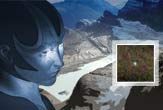
© Unknown
Could an alien astronomer have detected life on Earth during an ice age? Recent work has calculated how past climate extremes affected the light reflected from vegetation out into space. The results could give hope to our own search for life on distant worlds.
From far away, our planet is a single faint speck of light in the sky. Although we have sent radio
messages out to potential extraterrestrial listeners, none of these signals have traveled more than a few tens of light years.
However, Earthlings have been broadcasting their presence to the galaxy for millions of years. Terrestrial plants reflect strongly in the infrared, resulting in a distinctive feature (called the vegetation red edge or VRE) in the light bouncing off the Earth's surface.
"We know from earlier works that vegetation was detectable in the contemporary spectrum, but was vegetation visible when the Earth was much colder than today?" wonders Luc Arnold from the Observatory of Haute Provence in France.
Arnold and his colleagues have taken climate models from a recent ice age, as well as a recent warm period, and used them to generate the reflection spectrum of the Earth in times past. Their results, to be published in an upcoming issue of the
International Journal of Astrobiology, show that the VRE has remained a relatively constant interstellar
beacon over the millennia.
Earth from afarWhen the Apollo astronauts shone their cameras on Earth, we got a first glimpse of what our
planet looks like from space.
But at farther distances, continents and oceans blur together, and all that is left is a pale blue dot. Several spacecraft - most recently the European Space Agency's Venus Express - have looked back at Earth from different points in the solar system.
These self-portraits are not merely a case of narcissism on the part of us Earthlings. There is an important scientific question being posed: How does a planet brimming with life appear from far away?
The data from spacecraft, as well as Earthshine collected from the moon, have shown that there are signatures of life in the spectrum of light reflecting from Earth.
For example, absorption lines from gases, like oxygen and methane, give some hint that biology is at work. Even more telling is a tiny notch in the spectrum at 700 nanometers, where the reflection suddenly becomes stronger towards longer wavelengths.
This edge - occurring right at the boundary between visible light and the infrared - is due to photosynthesizing plants. They absorb the visible part of the spectrum, where most of the energy is
found in sunlight. However, they reflect away the infrared - presumably to avoid overheating.
Past climatesDue to vegetation coverage, the Earth reflects 5 percent more infrared light than it would if there were no plants. Arnold and his colleagues were therefore curious if this tiny VRE signal remained observable during one of Earth's ice ages.
They focused on the Last Glacial Maximum (LGM), which occurred 21,000 years ago. Average temperatures were around 4 degrees Celsius lower than now, and ice sheets covered all of Canada and Northern Europe.
For comparison, they also examined a warm period 6,000 years ago, called the Holocene optimum (HO), when temperatures were roughly a half a degree Celsius higher than now, and plant life flourished in the Sahara.
"The [LGM and HO] are two extreme periods for which we have good knowledge of the climate," Arnold says.
Using paleoclimate models, the researchers determined the biome (e.g. tundra, tropical forest, desert) for every point on Earth during these two extremes.
Each biome reflects a different spectrum of light into space. The European Space Agency's GOME (Global Ozone Monitoring Experiment) satellite has flown over all of these biomes and recorded the reflection.
By combining the biome map and satellite data with models for cloud cover and sea ice, the team generated a globally-averaged spectrum for the Earth. The results showed that the VRE was a little smaller (about 4 percent) during the LGM, and a bit bigger (6 percent) during the HO.
"The main point is that
even in climate extremes the vegetation remained visible," Arnold says, and this is encouraging for future space missions aimed at detecting and characterizing extrasolar planets similar to Earth.
ET takes rootAstrobiologists have long pondered whether life on other planets might be detectable through spectral signatures. The assumption has been that
plant-like organisms on worlds that orbit a star similar to our sun will likely have evolved a similar absorption-reflection strategy as our plants.
"If we can detect a sharp feature that cannot be attributed to a mineral or a combination of minerals, it might be a sign of life," Arnold says.
Arnold and colleagues calculated that a VRE signal from an Earth-clone 30 light-years away could be detected, even if it were experiencing an LGM-type cold spell. (However, a climate much colder than this - with ice caps extending down to China - might snuff out the signal, Arnold says.)
The VRE detection assumes a 6-meter space telescope and 2 to 4 weeks of exposure time. No such telescope currently exists, but the Terrestrial Planet Finder - which is still in the design stage - might be in this size range.
"I think our paper shows that if continents on an Earth-like planet have vegetation, that should remain visible even during a colder than average climate," Arnold says.
Reader Comments
to our Newsletter